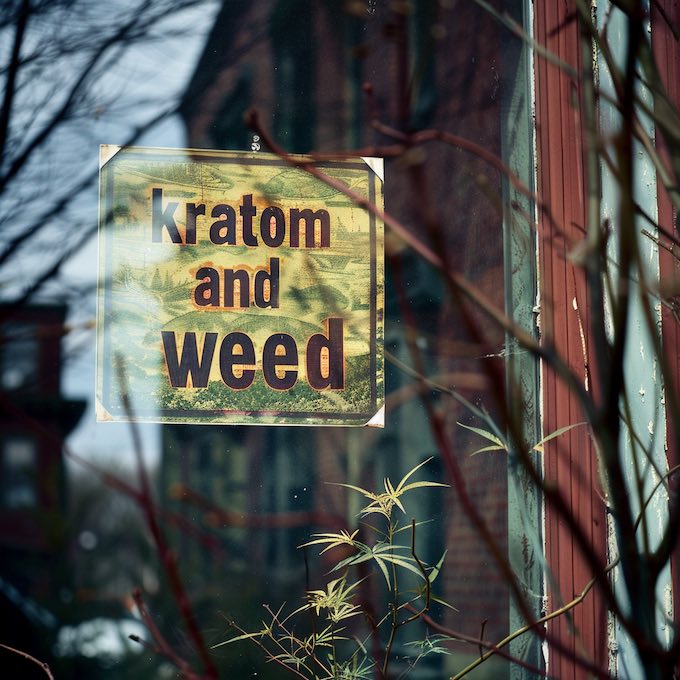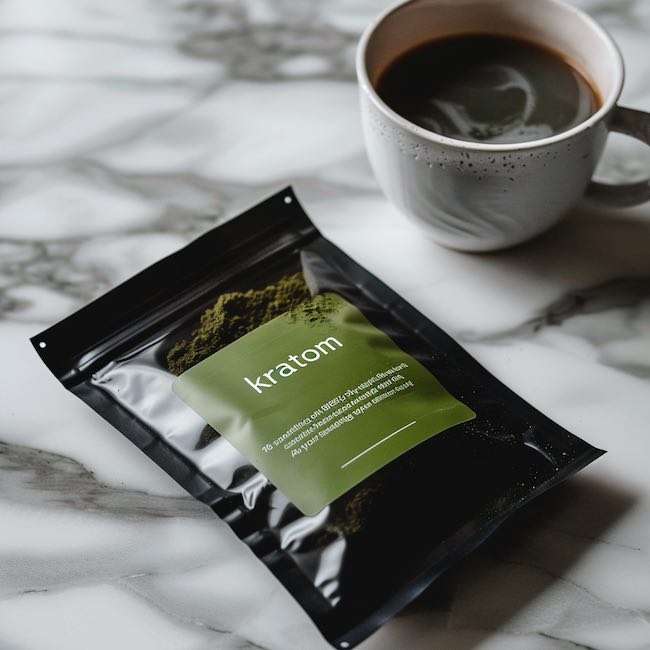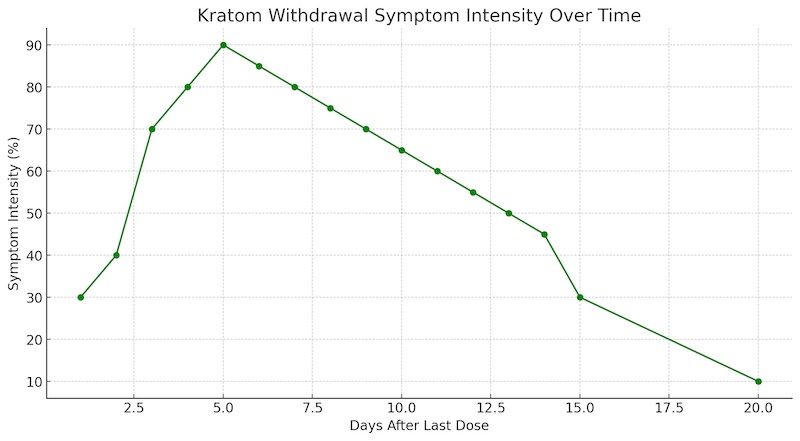With the rise of kratom drinks, kratom powders, and remedies widely available on the market, withdrawal symptoms from kratom are also on the rise.
Kratom, a tropical tree native to Southeast Asia, has gained significant attention in recent years. Known for their psychoactive properties, kratom leaves are often used for their stimulant and sedative effects.
However, as kratom use becomes more of a Gen-Z go-to drink product, a critical aspect emerges that users need to be aware of: kratom withdrawal.
What is Kratom?
Mitragyna speciosa also known as Kratom is a tree indigenous to Thailand, Malaysia, Indonesia, and Papua New Guinea. Its leaves contain compounds that can have mind-altering effects. Traditionally, kratom has been used in folk medicine for pain relief, energy boosts, and to help with opioid withdrawal. In recent times, it has gained popularity in Western countries for similar purposes, as well as for recreational use. However, frequent and prolonged use of kratom can lead to dependence, resulting in withdrawal symptoms when attempting to quit or reduce use.
According to research by National Institute on Drug Abuse;
Kratom leaves contain many chemical compounds (known as bioactive alkaloids) that influence the body. The most well-studied kratom-related compounds are mitragynine and 7-hydroxymitragynine. Mitragynine is found in kratom leaves and breaks down into 7-hydroxymitragynine in the body when digested. Both activate mu-opioid receptors (specific molecular structures on the surface of nerve cells), but the resulting effects only partially compare to those of opioids like heroin or oxycodone.
Facts about Kratom
- Kratom leaves contain alkaloids that can induce a range of effects, ranging from hallucinations and euphoria to sedation.
- The plant’s active components have multiple properties, including analgesic, astringent, stimulant, and tonic actions.
- Historically used as an opium substitute, kratom’s addictive potential has led to its ban in several countries.
- The chemical substances in kratom exhibit pain-relieving and sedative properties.
- Kratom’s compounds show promise as innovative pain relievers.
- In Asia, kratom is used for local anesthesia and to treat health issues like hypertension, diabetes, dysentery, gastrointestinal parasites, and stomachaches.
- Externally applied kratom leaves serve as poultices for wounds and, in combination with other medicinal plants, to treat spleen enlargement.
- Kratom leaves are consumed in Asia for their stimulating effects, fatigue reduction, and as an opium alternative.
- At high doses, kratom’s plant chemicals have a morphine-like impact.
- Kratom is employed in treating opium addiction.
- In Thailand and Malaysia, kratom products treat intestinal worms, cough, diabetes, hypertension, chronic pain, and gastroenteritis.
- The leaves are also used for their fever-reducing, anti-inflammatory, and analgesic effects.
- Despite its medicinal value, recreational misuse of kratom, especially with other substances like caffeine, alcohol, and pharmaceuticals, is widespread globally.
- In Thailand, kratom combinations with other chemicals, including pharmaceuticals, have been linked to fatalities.
Kratom Withdrawal Symptoms
Physical symptoms often include muscle aches, fatigue, tremors, nausea, sweating, and headaches. Users may also experience psychological symptoms such as anxiety, irritability, mood swings, and cravings for kratom. These kratom withdrawal symptoms can be quite distressing and may resemble those seen in opioid withdrawal, though they are less severe. These symptoms typically begin within a few hours and end after several days of stopping or reducing the use of the drug.
How Long Does Kratom Withdrawal Last?
The timeline for Kratom withdrawal can vary depending on the individual and their usage. Generally, the acute symptoms can last 3-7 days, followed by a protracted withdrawal phase which can last weeks to months. However, it’s important to note that each person’s withdrawal experience may be different. Acute symptoms typically occur within 6-12 hours after the last dose and subside after about a week. However, some individuals may experience post-acute withdrawal symptoms for months. Building a support network, seeking professional help, and practicing healthy habits can greatly assist in the recovery process.
Kratom Withdrawal Timeline
Days 1-2: You might start feeling withdrawal symptoms like anxiety, restlessness, muscle aches, and flu-like signs such as a runny nose and sweating.
Days 3-5: This is when withdrawal symptoms usually hit their peak. You could experience more severe physical and psychological discomfort, including heightened anxiety, depression, insomnia, and strong cravings for kratom.
Days 6-14: During this time, you’ll likely see a gradual decrease in withdrawal symptoms. You might still feel some anxiety, depression, and cravings, but these should start to lessen. You may begin to notice a sense of relief and an improvement in how you’re feeling overall.
Days 15 and beyond: By now, most people see a significant drop in their withdrawal symptoms, though some may still experience lingering effects.
Factors Influencing Withdrawal Severity
The severity of kratom withdrawal symptoms can be influenced by several distinct factors, each playing a crucial role in how an individual experiences withdrawal:
- Duration of Kratom Use: Prolonged use of kratom often leads to the body developing a dependence. The longer a person has been using kratom, the more likely their body is to react negatively when the substance is no longer provided, resulting in more intense withdrawal symptoms.
- Dosage and Consumption Patterns: Higher doses of kratom are more likely to result in severe withdrawal symptoms. Additionally, the method of consumption (such as chewing leaves, brewing tea, or ingesting capsules) and the frequency of use also play significant roles. Regular, daily consumption, for example, often leads to more severe withdrawal symptoms compared to intermittent use.
- Individual Physiology and Genetics: Each person’s body reacts differently to kratom, influenced by genetics, metabolic rate, and overall body chemistry. These individual differences can cause significant variations in withdrawal experiences, even among individuals who use kratom in similar amounts and durations.
- Concurrent Substance Use: The use of other substances alongside kratom can complicate withdrawal. For instance, using kratom to manage withdrawal from opioids may lead to a more complex withdrawal process. Similarly, the simultaneous use of other substances, like alcohol or prescription medications, can intensify withdrawal symptoms.
- Psychological Factors: Mental health conditions and psychological factors play a significant role in the experience of withdrawal. Stress, anxiety, and underlying mental health disorders can exacerbate the psychological symptoms of kratom withdrawal, such as anxiety and mood swings.
Coping with Kratom Withdrawal
Users must slowly taper off kratom to make withdrawal easier to handle. Also, therapies like counseling and joining support groups can make a difference. Self-care practices, including maintaining a healthy diet, regular exercise, and good sleep hygiene, can also help reduce withdrawal symptoms. If you feel like you won’t be able to do it on your own, don’t worry – Still Detox is here to help you overcome your addiction. Call now to get help: (561) 556-2677
Conclusion
Even though Kratom is a widely popular and easy-to-find natural product, this doesn’t mean that it’s a dangerous one. It’s important to use it responsibly and be aware of the potential for addiction and withdrawal.
Dealing with kratom withdrawal can be challenging, and getting the right support is key. Doctors might use medicines like benzodiazepines and NSAIDs to help with withdrawal symptoms. It’s also really important to take care of your mental health during this time. Keeping your mind busy with things like books, movies, or hobbies can help a lot.
If you or someone you care about is struggling with kratom withdrawal, getting professional help is crucial for a safe and effective recovery.










